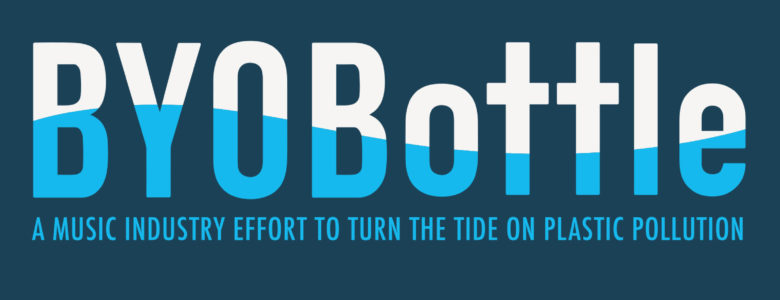January 9, 2020
BYOBottle: The Future of Sustainable Concerts and Festivals

By: burgundy bug
BYOBottle: A music industry effort to turn the tide on plastic pollution
Source: BYOBottle Resources
Nothing looks more like a music festival than rubber bracelets, band t-shirts, flower crowns, and countless water bottles littering the ground.
…What, can you blame the attendees? Staying hydrated is vital to survival, and it’s all the more important when you’re dancing your heart out or drinking your face off at a festival, as stressed by the data in a 2018 Addiction Science and Clinical Practice study.
But we don’t have to dehydrate the audience in order to help save the planet, nor do we have to put an end to festivals altogether.
There’s a middle ground that allows us to have the best of both worlds: water and music. Meet BYOBottle.
BYOBottle
The BYOBottle Campaign is a global initiative to reduce plastic waste at music venues and festivals by promoting the use of reusable bottles and water refill stations.
“The collaborative BYOBottle Campaign encourages artists to travel with reusable water bottles and include green rider language,” says a recent press release from Oniracom, a marketing and technology partner of BYOBottle. “Venues, festivals, and promoters commit to providing water refill stations for artists and fans.”
BYOBottle is lead by The Sustainable Concerts Working Group, a network of music industry experts and environmental advocates who believe in a sustainably-driven music community, says the BYOBottle about page.
“The campaign is modeled after Green Music Australia’s BYOBottle Campaign, with SCWG building off that initiative to amplify the BYOBottle commitment to artists and venues globally,” BYOBottle says. “Fans can also make the BYOBottle commitment and show their support of the music industry’s efforts to reduce single-use plastic waste.”
30 venues, 50 non-profit business partners, 800 fans, and over 200 artists signed off during the Earth Day kick-off, including: Maroon 5, P!nk, Wilco, Ben Harper, Empire of the Sun, SWMRS, Flume, CHVRCHES and The Lumineers, says Oniracom.
A full list of BYOBottle Partners is available online, as well.
Plastic Pollution: Why it Matters
“If current production and waste management trends continue, roughly 12,000 Mt of plastic waste will be in landfills or in the natural environment by 2050.”
Production, use, and fate of all plastics ever made | Science Advances
Plastic is a non-biodegradable material, and 91 percent of it isn’t recycled, according to a 2017 Science Advances study.
“We estimate that 8,300 million metric tons (Mt) as of virgin plastics have been produced to date,” the study states. “As of 2015, approximately 6300 Mt of plastic waste had been generated, around 9 percent of which had been recycled, 12 percent was incinerated, and 79 percent was accumulated in landfills or the natural environment.”
Moreover, plastic has found its way into our rivers and oceans. Not only does this affect marine life, but it affects our health, too, says a 2012 case study from the Science and Education Resource Center at Carleton College.
“The toxins from the plastics have entered the food chain, threatening human health. In the most polluted places in the ocean, the mass of plastic exceeds the amount of plankton six times over.”
Plastics in the Ocean Affecting Human Health | SERC
Plastic contributes to toxins in the ocean, but it also absorbs other toxins in the ocean. These chemicals are then ingested by fish and animals, which we then ingest. Yuck.
The waste in our oceans has amounted to five garbage patches, the largest being the “Great Pacific Garbage Patch” (a.k.a. the “Pacific Trash Vortex”), which is located in the central North Pacific Ocean and larger than the size of Texas.
“Plastics are transported and converge in the ocean where currents meet,” the SERC study explains. “This means that huge plastic islands are made as a result.”
Where is All This Plastic Coming From!?
20 percent of trash in the ocean comes from ships and offshore platforms. The rest is litter that has been blown into our open waters.
Adding insult to injury, plastic production is increasing all around the globe.
“In 1950 the world produced only 2 million metric tons per year,” says research by Our World in Data. “Since then, annual production has increased nearly 200-fold, reaching 381 million metric tons in 2015. For context, this is roughly equivalent to the mass of two-thirds of the world population.”
The packaging industry is responsible for the most plastic production, accounting for almost 146 million mt as of 2015.
What About Water Bottles?
1,000,000 water bottles are being purchased around the world every minute, says the Earth Day organization fact sheet.
In the United States, 50 billion water bottles are bought annually, which breaks down to about 13 water bottles bought each month by every person in the US.
“That means by using a reusable water bottle, you could save an average of 156 plastic bottles annually,” the Earth Day organization adds.
In Conclusion
Plastic pollution is a major environmental issue that our species created and is now an issue affecting the entire planet.
Water bottles contribute to the problem, especially during events like concerts and music festivals… And, we can’t just not have water at concerts and festivals.
Fortunately, the BYOBottle Campaign offers a solution. So grab your reusable water bottle and join the movement!
Interested in having content featured in an upcoming blog post or issue of The Burgundy Zine? Head on over to the submissions page!
For all other inquiries, please fulfill a contact form.


